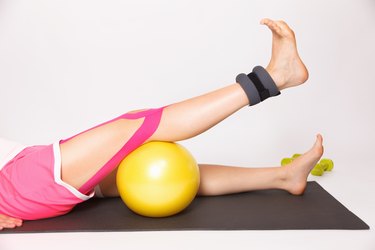
Hypergravity training is any type of exercise that includes wearing ankle weights or a weight vest. Taking this approach all day can help you build muscle, gain strength and burn calories. Learning more about resistance exercises will allow you to make wise health decisions.
Tip
If you are trying to get fit, wearing ankle weights all day can make a small difference. Yet this approach is inconvenient, and it might damage your joints. Short-duration, high-intensity exercises like stair climbing will give you a more effective workout.
Video of the Day
Read more: Importance of Working Out Your Legs
Video of the Day
Benefits of Wearing Ankle Weights
The writers of a November 2012 report in the Journal of Strength and Conditioning Research looked at the effects of all-day hypergravity. In this study, eight men wore a weight vest all day for three weeks. Results indicated a small increase in agility, compared to control subjects.
Because the effects were small, the authors recommended using hypergravity tools only for short periods of exercise. They also suggested using implements that add 5 to 10 percent of additional weight, based on how much you weigh, to your body.
Consistent with these guidelines, the authors of an August 2016 report in the Journal of Taibah University Medical Sciences tested the effects of ankle and wrist weights in 69 healthy adults. The participants wore the weights during their normal activities for three 20-minute periods each week for six months.
This natural use caused a decrease in body fat and increase in muscle mass. Using the weights also decreased waist circumference and waist-hip ratio. Given these impressive results, there's no reason for you to be wearing wrist weights all day.
Risks of Wearing Ankle Weights
Doing aerobic activities like running for many years might cause joint damage, according to a June 2017 article in the Journal of Orthopaedic and Sports Physical Therapy. The exact mechanisms underlying this relationship remain unknown, but they may involve the ground reaction forces generated while running.
These forces could damage the soft tissue found in your lower body. The authors of a June 2014 paper in Human Movement Science tested 20 healthy adults and found that wearing ankle weights increases the magnitude of these forces.
Because of these issues, the writer of a March 2018 article from the Mayo Clinic recommended avoiding ankle weights. It lists the alternatives available to you, such as doing resistance exercises with elastic tubing. Yet you need to find an exercise routine that works for you. If that routine features hypergravity training, there are safe ways to include it.
The authors of a May 2012 report in the journal PM & R describe some safety options for runners that might apply to hypergravity exercise. These researchers believe that low-volume aerobic activities don't pose a significant risk to healthy individuals.
They do, however, suggest taking a gradual approach to exercise. Thus, you should slowly incorporate ankle weights into your routine. It's also important to include periodic breaks — so it's not wise to wear ankle weights all day. You should also avoid jumping, to prevent muscle and tendon damage.
Read more: Should I Lift Weights Every Day?
Utility of Hypergravity Training
The positive effects of wearing ankle weights create clinical opportunities. Physical therapists use the Otago exercise program to prevent falls in older adults. This program relies on using ankle weights for resistance training.
The writers of February 2019 paper in the International Journal of Medical and Exercise Science tested 40 patients with osteoarthritis using the Otago program. Results indicated that ankle weight training had a greater effect than traditional strength training. It successfully increased lower body strength, and thus decreased fall risk.
Hypergravity training can also benefit recreational athletes. The writers of a January 2015 paper in the Journal of Science and Medicine in Sport tested 11 long-distance runners and found that wearing a weight vest for 10 minutes while warming up improved their athletic performance.
This simple protocol increased running speed and running economy. The authors believe that these changes will increase performance in athletic competitions. They might also decrease your injury risk.
Read more: How Long Should a Warm-Up Last?
Warning
Please talk to your doctor before using ankle weights regularly.
- Journal of Strength and Conditioning Research: "Effect of Weighted Vest Suit Worn During Daily Activities on Running Speed, Jumping Power, and Agility in Young Men"
- Journal of Taibah University Medical Sciences: "Dumbbells and Ankle-Wrist Weight Training Leads to Changes in Body Composition and Anthropometric Parameters With Potential Cardiovascular Disease Risk Reduction"
- Journal of Orthopaedic and Sports Physical Therapy: "Association of Recreational and Competitive Running With Hip and Knee Osteoarthritis"
- Human Movement Science: "Exploration of Load Accommodation Strategies During Walking With Extremity-Carried Weights"
- Mayo Clinic: "Could Ankle Weights Help Me Get More Out of My Usual Walking Routine?"
- PM & R: "Does Running Cause Osteoarthritis in the Hip or Knee?"
- International Journal of Medical and Exercise Science: "Effect of Otago Exercise Program (OEP) and Strength Training Program (STP) on Leg Strength and Risk of Fall Among Bilateral Knee Osteoarthritis Patients"
- Journal of Science and Medicine in Sport: "Warm-Up With a Weighted Vest Improves Running Performance via Leg Stiffness and Running Economy"